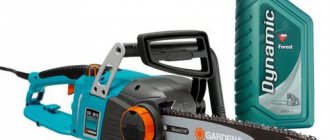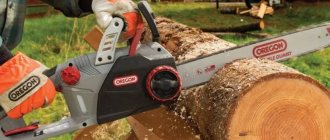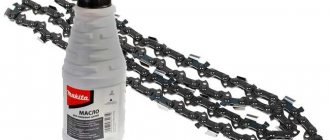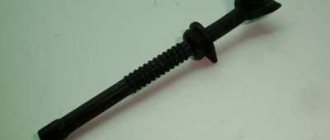When the saw chain of a chainsaw moves in the groove of the bar due to friction, a large amount of heat is released. If oil does not flow to the chainsaw chain, it is necessary to stop work and take all measures to eliminate the malfunction of the lubrication system. The combination of heavy loads and overheating of the headset is accompanied by its accelerated wear and early failure.
- Without exception, all chainsaws and their electric analogues are equipped with systems of the same operating principle, through which the lubrication of the bar, saw chain and its drive parts is carried out.
- The standard composition of this device includes a reservoir from which chain oil is supplied to the inlet of a pump with a fixed or adjustable capacity.
- Next, the working fluid in a dosed amount enters the groove of the bar, in which it is evenly distributed by the shanks of the saw chain over the entire headset and the working surface of the drive sprocket crown.
Performance tires with a length of 400 mm or more are equipped with a driven sprocket. Periodic lubrication of the bearing is carried out individually, after 6-8 hours of operation.
Lubrication system malfunctions and how to fix them
The main malfunctions of the oil supply system on a chainsaw can be divided into two main types: these are general malfunctions inherent in all chainsaws and individual ones, which may vary depending on the type of pump and worm gear installed on a particular model. Let's begin to understand the faults in order.
Signs of a malfunction of the lubrication system, checking its performance
- The chainsaw chain is dry and has a pale tint without shine.
- The chain stretches relatively quickly.
- The tire is very hot and may even partially melt the paint.
- The oil from the tank is practically not reduced.
- Reduced cutting efficiency on a sharp chain
All these signs indicate that the lubrication process is not proceeding properly. In order to check the oil supply to the lubrication system, you need to remove the side tire of the chainsaw and start it. Next, you need to slightly increase the speed while observing the end of the oil line. If oil comes in, most likely the amount is not enough for normal lubrication and you need to clean or replace the filter and, if possible, adjust the flow. If it does not, the problem is more serious and requires further diagnosis.
Have you encountered such a problem? What to do?
We have already repaired electric saws and eliminated the defect of no oil flowing to the chain. This malfunction can be treated by service engineers at any Umedia service centers. The price for repairs without parts is 1,500 rubles. Diagnostics with analysis at the service center is free. The terms of this service are minimal. Has your equipment stopped working? What to do? — Bring it to any one of 21 Umedia services and we will fix it!
Main brands of motor oils for chainsaws
The leaders in the production of high-quality lubricants for chainsaws and brush cutters are the companies Shtil and Husqvarna. Their range includes both conventional mineral lubricants for two-stroke engines and synthetic oils for severe operating conditions. Let's take a closer look at the range.
STIHL HP
STIHL HP mineral lubricant was specially developed by STIHL engineers for use in their tools. That is why owners of Shtil chainsaws and lawn mowers are recommended to use this type of oil.
Its color is red, shelf life in a closed container is no more than four years. It is packaged in several types of containers, so you can choose the most convenient packaging for yourself. Not so long ago, convenient containers of 20 grams appeared, which are diluted with one liter of gasoline. For those who rarely use a chainsaw, this is the best option. Can be diluted and used immediately.
STIHL HP fully complies with high European standards.
HP Ultra
Another oil from Stihl. It has a synthetic base, due to which it has improved combustion characteristics, cleanliness and engine protection.
Recommended by the manufacturer for long-term use in harsh conditions. Ideal for working at low temperatures. HP Ultra does not harm the environment, since oil spilled on the ground decomposes by 80% in just 21 days.
Packaged in two types of containers, 100 ml and liter bottles. The proportion of the finished fuel mixture is 1:50, which means a 100 mm bottle is enough to prepare 5 liters of the mixture. Green color. Shelf life 4 years.
The cost of this oil is significantly higher than the cost of STIHL HP, so it is not profitable to use it constantly.
It is worth noting that Stihl oils, before going on sale, go through the company’s laboratory, where they are tested to ensure they meet all requirements.
When developing oils, much attention is paid to fuel combustion, cold start characteristics, biodegradability, and viscosity change at different temperatures (information from the company’s official website)
Husqvarna HP 2-stroke
Husqvarna HP oil, like its STIHL HP counterpart, is also designed specifically for 2-stroke engines.
According to the manufacturer, this type of oil has additives that compensate for the low quality of fuel, which is important for our country. The declared octane number of gasoline at gas stations rarely corresponds to the real one.
Husqvarna HP – semi-synthetic, green. Packaged in liter or ten liter containers. The proportion of the mixture is 1: 50, i.e. 20 grams per liter. During the period of running in the saw engine or when working in cold weather, it is possible to increase the proportion to 1:40, which will give the engine greater protection and increase its service life.
Today, there are a large number of lubricants for two-stroke engines on the market from different manufacturers. For this reason, answering the question of which chainsaw oil is best is quite difficult. Our opinion is that you should trust reliable companies, which are Shtil, Husqvarna, Oregon, Champion. It is their oils that will maximize the protection of your tool’s engine and extend its service life.
Unscrupulous manufacturers often disguise their products under well-known brands (Husqvarna, Shtil, etc.). Such oils are of low quality and can harm the engine. In order not to be deceived, it is necessary to purchase lubricants from official representatives who have the necessary certificates for the products. You can learn how to distinguish a fake from an original from the video:
Semi-synthetic oil of the Stihl brand
Very often, owners of such chainsaws wonder what kind of oil can be used for the saw. Its operation may be affected by:
- cutting set;
- climate;
- wood species
To solve this problem, the Shtil company developed a universal semi-synthetic oil. It is suitable for all high-speed chainsaws. Under any conditions, chains can be lubricated with this oil. The tool will work flawlessly.
Since Shtil semi-synthetics are intended for chains, they are made from special high-quality materials and do not contain various toxic substances that can cause cancer. The oil fully meets the most stringent environmental requirements.
The Russian climate is quite harsh. There are areas in our country where frosts often exceed -20°C. The latest Stihl chainsaw chain oil has been specially developed for use in cold conditions. In such frost it demonstrates excellent fluidity.
Special additives included in the oil prevent the cutting set from becoming oily; they will extend the life of other lubricated parts. A saw with this oil starts easily even after long-term storage.
The use of such chain lube reduces wear on the saw chain. Due to the high endurance of the oil at high temperatures, the cutting set is ideally protected. This oil is not afraid of peak temperature loads. Smoke almost never appears.
Of course, anyone who owns a chainsaw knows how important good quality oil is. And, everyone dreams, there is no need to say what it really is, that this is the typical “life force” of a given device for producing real and effective work
Today there is an unlimited number of oils and, as the saying goes, the choice is very large.
But, often, not every owner of electrical equipment of this kind knows what kind of oil to use for his steel friend, so that the operation of the chainsaw is not only easy, but also productive. Therefore, below we will discuss the issue regarding the correct choice of the manufacturer of the calm. Also, what it is to help the chainsaw in its time of its specific activity, and not harm. Let's get started with what we need.
Read also: Bimetallic crown for wood
Do-it-yourself adjustment of the Partner 350 chainsaw carburetor
Before you start tuning the standard carburetor of the Partner model, you need to thoroughly clean it of dust, dirt and carbon deposits that have accumulated on the walls. In addition to the carburetor, you will need to wash and dry the fuel and air filters. Otherwise, the operator will not be able to accurately set the required engine speed.
In the upper left part of the protective plastic body of the Partner saw there are holes, inside of which the manufacturer provides bolts for adjusting the carburetor. Having found them, you can begin basic configuration of the node. To do this, the left and right screws, which are responsible for the quantity and quality of revolutions, respectively, must be set to the fully tightened position. Immediately after this, they must be loosened by 1/5 of a turn. The third adjustment bolt, marked T, must be left in the position in which it is installed.
The final adjustment of the Partner 350 chainsaw carburetor is performed in the following order:
- First you need to start the saw and let its motor run to fully warm up;
- After 5 minutes you can start adjusting. First, you need to start turning the left bolt in the direction of the clock until the engine reaches maximum speed. Then the left bolt must be turned 1.4 turns in the opposite direction. After performing these steps, the Partner chainsaw engine should idle confidently;
- If, after manipulating the left adjusting screw, the chain on the bar begins to rotate, then it must be stopped by alternately turning the bolt T;
- Then you need to move on to adjusting the quality of the fuel mixture. To do this, the right adjusting screw will need to be turned in the direction of the clock hand. As soon as the motor reaches the maximum permissible speed, the screw must be unscrewed 1/4 turn in the opposite direction.
Operating principle
The main unit of the system is the pump. The principle of its operation is as follows. When the engine speed increases, a gear mounted on the main shaft drives the pump shaft through the worm gear. In turn, the rotation of the shaft creates a certain pressure in the oil line, which forces the oil to move along it towards the tire.
Read:
The end of the oil channel is located at the point of contact of the tire with the tool body, where there is a longitudinal groove on which, when the tire is installed, the oil channel enters it.
Threading is necessary to ensure that oil flows into the bar regardless of the chain saw's chain tension. Simply put, in any position that the tire has during operation, oil will fall through the hole onto it.
Next, the lubrication process involves a chain, on the links of which, depending on the chain model, there is either a groove or a hole through which the oil is accelerated throughout the tire. As the engine speed increases, the oil flow rate also increases.
Some chainsaw models are equipped with pumps that additionally have power adjustment, and if necessary, the amount of oil supplied by the lubrication system can be increased or decreased.
Lubrication system malfunctions and how to fix them
The main malfunctions of the oil supply system on a chainsaw can be divided into two main types: these are general malfunctions inherent in all chainsaws and individual ones, which may vary depending on the type of pump and worm gear installed on a particular model. Let's begin to understand the faults in order.
Operating a chainsaw without lubricating the chainsaw chain is prohibited. This has a detrimental effect on the bar, drive sprocket and chain, and can result in significant repair costs.
Signs of a malfunction of the lubrication system, checking its performance
- The chainsaw chain is dry and has a pale tint without shine.
- The chain stretches relatively quickly.
- The tire is very hot and may even partially melt the paint.
- The oil from the tank is practically not reduced.
- Reduced cutting efficiency on a sharp chain
All these signs indicate that the lubrication process is not proceeding properly. In order to check the oil supply to the lubrication system, you need to remove the side tire of the chainsaw and start it. Next, you need to slightly increase the speed while observing the end of the oil line. If oil comes in, most likely the amount is not enough for normal lubrication and you need to clean or replace the filter and, if possible, adjust the flow. If it does not, the problem is more serious and requires further diagnosis.
There is a way to check the oil supply without removing the tires. To do this, you need to point the end of the bar towards, for example, a freshly cut piece of wood from the side of the cut and increase the speed as much as possible, while trying to keep the end of the bar at a distance of no more than 10 cm from the block. If oil spots begin to appear on its surface, it means the oil is being supplied.
Troubleshooting
Once it has been determined that oil is not being supplied, further diagnosis is only possible if the oil system is completely removed. Of course, in some situations replacing the filter helps, but this is very rare.
Access to the oil pump of some models of saws is possible only after complete disassembly; therefore, without having the skills to repair gas-powered tools, it is better to entrust repairs to professionals.
Most common faults
- Broken oil hose. It can sometimes be detected by visual inspection. The problem is solved by replacing the faulty part.
- There is no thread on the oil pump shaft; replacing it will help.
- A defective thread on the pump drive gear can be similarly solved by installing a new part.
- Lack of main shaft corkscrew (relevant for some instrument models, for example, Homelite). You can fix it by installing a nail of a suitable diameter instead of the original corkscrew, cutting it to the required length.
- Blockage in the line. Can be removed by blowing with compressed air or mechanically, using a wire of a suitable diameter.
- Filter element clogged.
- The Stihl MS 180 tool, whose pump is not dismountable, often gets clogged. You can try to wash it in clean gasoline, if that doesn’t help, replace it.
- In Chinese chainsaws (Gypsy), it very often cuts off the grooves on the main gear, through which the force from the sprocket is transmitted to it.
Individual malfunction of the Stihl MS 180 lubrication system
Due to the fact that the Stihl MS 180 is one of the most common models of chainsaws, I would like to dwell in more detail on one fault inherent only to it and describe a method for eliminating it without replacing parts.
Quite often, on the Shtil MS 180 chainsaw, depressurization of the oil line is observed in the place where the oil line coming from the tank is installed in the saw body. The malfunction can be determined by the characteristic lubricant leaks on the bottom of the tool.
To eliminate the problem, you need to remove the chainsaw handle, remove the hose from the mounting hole, clean and degrease. After all these manipulations, apply sealant to the hose seat and install it into the chainsaw body.
You can learn more about troubleshooting and complete diagnostics of the lubrication system of the Stihl chainsaw by watching a video that shows the step-by-step process of disassembling and repairing the lubrication system.
Possible reasons for fuel failure
Oil to the chain only if there are two breakdowns. These include:
- problems with air leaks;
- failure of the oil pump .
Basic parameters of a chainsaw chain.
The main cause of failure is air leaks. This can happen due to depressurization of the oil hose while using the chainsaw. In this case, it is necessary to remove the hose from the hole. This must be done in the place where it is connected to the crankcase. Then the hose is seated on the sealant and installed in its usual position. If this doesn't help, there's likely been a loss of elasticity. For further operation of the chainsaw, it is advisable to replace the hose.
The second reason is a breakdown of the oil pump . In common parlance this part is called a worm. When the drive fails, oil will stop flowing to the chain . The oil pump drive is a round plastic ring with grooves inside. Constant use of a chainsaw leads to wear of the internal parts, resulting in the metal hook located inside the drive being chipped. After this breakdown, oil stops flowing to the chain .
Lubrication system design
Depending on the brand of chainsaw, the parts of the lubrication system may vary slightly in design, but their total number and connection diagram remain the same.
The main components of the lubrication system are:
- an oil tank located, as a rule, in the engine crankcase.
- The filter element is installed in the tank.
- The oil line is a small diameter hose made of oil-resistant rubber.
- The heart of the system is the oil pump.
- The worm gear transmits force from the engine to the pump.
- The chainsaw tire can also be considered an element of the lubrication system, since it has special holes for supplying oil. By the way, the chain itself is involved in transporting oil and, accordingly, also has some elements designed specifically to provide lubrication.
MAINTENANCE INSTRUCTIONS FOR THE STIHL MS 250 CHAINSAW
Weekly
- checking saw chain tension and sharpening condition
- deburring the guide bar
- checking the chain sprocket
- cleaning the fan housing
Monthly
- checking and cleaning the suction head
- checking and cleaning the filter in the fuel tank
- replacing the filter element
- Cleaning the fuel tank and lubricating oil tank Cleaning the cylinder fins
carries out scheduled and emergency repairs, as well as maintenance of chainsaws in accordance with the recommendations of equipment manufacturers.
Chainsaw Partner 350 – malfunctions and their elimination
Failures of Partner garden tools can occur for various reasons, the most common of which are improper operation and mechanical shock. To eliminate the malfunction, you will need to determine its exact cause in advance. After this, you can begin repairing the instrument yourself.
Chainsaw Partner 350 starts and stalls
There may be several reasons for this malfunction. Most often, the engine of the tool starts and immediately stalls due to a clogged factory breather, as a result of which fuel does not enter the engine cylinder in sufficient quantity for operation. To fix the damage, you will need to remove and clean the breather. If it is damaged, then it will need to be replaced.
Another reason is the missing connection between the spark plug and the electrical wiring cap. This can happen due to mechanical shock or the formation of carbon deposits from engine oil on the spark plug. To repair the Partner 350 chainsaw, the spark plug will need to be removed and cleaned. In some cases, completely replacing the spark plug may help.
The third reason for the malfunction is that the standard muffler of the chain saw is severely clogged. Over time, carbon deposits form on its walls, which prevents exhaust from leaving the engine. As a result, gases accumulate inside the engine and interfere with its proper operation. To fix the damage, you need to remove the muffler and clean it with compressed air. You will also need to disassemble the engine and bleed its cylinder.
Chainsaw Partner 350 will not start - how to fix the problem?
When this breakdown is detected, the first thing that needs to be inspected is the condition of the air filter. If a large amount of dust has accumulated on it, the filter will need to be washed using clean gasoline.
Another common cause of malfunction is problems with the ignition system. To repair the chain saw, you need to remove its left protective cover and set the correct clearance between the flywheel and the ignition coil.
In some cases, replacing the fuel mixture will help solve the problem. To do this, you will need to drain the used fuel and fill the tank with a new mixture of pure gasoline and motor oil.
What to do if the chain on the Partner 350 chainsaw is not lubricated?
If the chain for the Partner 350 chainsaw is no longer lubricated with oil, this can lead to overheating of the bar and rupture of the saw set. Ignoring this problem also risks increasing the load on the engine, which can lead to engine failure.
The first thing you need to inspect if there is no lubrication on the chain is the oil pump. Over time, the teeth on its drive wear out, which can also occur due to clogging of the pump. It is usually impossible to restore the element, so it is best to replace it.
Often, lubricant does not reach the chain of the Partner 350 chainsaw due to clogged oil pipes. In this case, the hoses will need to be replaced by treating the joints with the fittings with sealant.
Fills a candle on a Partner 350 chainsaw
This common problem is encountered by chainsaw owners who add too much motor oil to the fuel mixture. It does not have time to burn in the cylinder, so part of the lubricant settles on the spark plug and other important elements of the garden tool.
To fix the breakdown, you need to remove the factory spark plug, clean it of carbon deposits and dry it. After this, you need to blow out the cylinder of the factory chainsaw engine by sharply pulling the starter cable several times.
Next, you need to inspect the condition of the carburetor and fuel hoses. Often oil gets on the spark plug due to loss of tightness of the system. This occurs as a result of a break in one of the tubes or a breakdown of the oil pump. To repair a Partner 350 chainsaw, you will need to replace all faulty fuel system parts. After this, you need to install the spark plug in place, start the engine of the tool and check its operation at idle, low and high speeds.
One of the important chainsaw systems, without which work is impossible, is the forced lubrication system of the chainsaw chain. It's no secret that when the saw is running, the chain rubs against the chainsaw bar, which causes it to heat up and cause premature wear. To soften friction, the chain mechanism must be constantly lubricated.
Stihl ms 250 repair (Part 1)
As mentioned earlier, the inspection of a faulty saw tool should begin with establishing the presence of gasoline in the fuel tank, as well as determining the technical condition of the breather.
Repair of a Shtil chainsaw in case of a malfunction in the accounting software (software) for fuel supply.
When checking the fuel level, you should immediately open the gas tank cap. This must be done even for which the design is intended, if the owner of the tool can be sure that there is gasoline in the tank.
Often the saw is unable to start due to fuel not entering the combustion chamber. The prerequisite for this in most cases is the usual clogging of the breather - a special bypass valve that serves to equalize the pressure in the container with the gradual consumption of gasoline. Here, repairing a chainsaw comes down to carefully cleaning the breather with a regular sewing needle.
A prerequisite for failure of the entire tool will be an inoperative starting mechanism or problems in the ignition system. If it turns out that the starting device works as usual, then you need to make sure that the spark plug is working properly. In order to do this, the spark plug is unscrewed from the socket and closely inspected, looking for the presence of foreign deposits on its electrodes.
Chainsaw starter device.
It should be noted that the presence of traces of a certain characteristic at the site of spark formation speaks very eloquently about the sources of “disease” of the entire starting accounting system. Such a source, for example, could be a carburetor. Thus, the complete absence of any signs of fuel on the spark plug (its complete dryness) most likely indicates a failure of fuel to pass into the combustion chamber due to a workable version of a clogged carburetor.
How to properly tension a chain on a chainsaw?
Well-known brands produce garden tools so that even an inexperienced beginner can install a chain on a chainsaw. To do this, almost every model has a side tensioner, which allows you to both put a chain on a chainsaw and tighten an already installed headset. Thanks to this mechanism, tensioning the chain on a chainsaw can be done with your own hands. In most cases, saw manufacturers provide free access to the tensioner, which greatly simplifies the replacement of the drive roller and other parts of the mechanism.
Installing a chain on a chainsaw should only be done when the motor and tire of the garden tool have completely cooled down. If you ignore this requirement, the cold saw element on the hot bar may become deformed. Moreover, this happens quite often even in cases where a victorious chain for a chainsaw is installed.
To properly put a chain on a chainsaw, you need to follow the following procedure:
- First you need to check whether the blocking of random activation of the garden tool is turned on. Also, the owner of the saw will need to turn on the inertia brake in advance;
- Next, you need to dismantle the protective plastic cover located on the right side of the saw and remove the screws;
- Then you will need to determine which side to place the chain on the chainsaw. Manufacturers advise installing the headset in such a way that the cutter located at the top of the installed bar is precisely directed directly in the direction of rotation of the chain;
- After this, you need to put on protective gloves made of thick material and begin to slowly rotate the headset on the bus;
- If the operator discovers that the saw element being used is slack, it will need to be tightened. To do this, you need to turn the tensioner until the part to be cut is tensioned;
- Then you need to loosen the screws, which are standardly intended for fastening the factory tire;
- Next you need to insert the tire and tighten the screws.
At the end, it remains to check the tension of the saw element again. When installed correctly, the chain should not sag and, at the same time, should not be tensioned too much. It is best that when pressing on it with the index finger of the hand, the part sag by about 0.5 cm.
Lubricant selection criteria
After purchasing the device, the question may arise about choosing oil to fill the Stihl chainsaw. After all, proper care of equipment increases its performance and saves you from all kinds of breakdowns. The performance of the saw directly depends on the use of good fuel and lubricant.
Stihl chainsaws have a carburetor two-stroke engine and 2 tanks (gasoline and oil). To choose the right oil for a Stihl saw, you need to know its criteria:
- It is necessary to determine the manufacturer, because domestic models use simple oils (for motorcycles) in a ratio of 1 to 25, and foreign ones use branded lubricants in a ratio of 1 to 40 (proportions of oil to gasoline). In fact, the owners themselves determine which one to use. You should be prepared that improper use will result in a decrease in power and productivity. Most people use motor oil; if not, then transmission oil. Experts advise using the latter for this manufacturer.
- You need to know the color. For chainsaws with a two-stroke engine, red, green, and blue colors are suitable.
- Compound.
Correct ratios and preparation for popular brands
Different manufacturers recommend different proportions for their chainsaws.
Their compliance should be treated with care. Lack of lubrication leads to engine failure
Excess leads to loss of power, smoking, formation of soot with all the problems described above.
How to dilute for Stihl, in particular for the MS 180 model
The manufacturer recommends HP Ultra oil in a ratio of 1:50 for the engines of its chainsaws, including the Shtil 180 MS model. It provides the greatest power, service life and cleanliness of the internal combustion engine. It is also recommended to use motor oils in cans marked STIHL
It is important to purchase original, but not counterfeit, products.
This is not the case with the mixture of oil and gasoline recommended by Stihl. The mixture can be stored for up to 2 years. After long-term storage, the container must be shaken to remove any sediment.
Motomix is a ready-made fuel mixture from Stihl, very convenient when there is no time or opportunity to mix liquids on site
How to thin a Husqvarna saw
The manufacturer recommends using special oil for HUSQVARNA in the operating instructions. It is adapted to the engines of this manufacturer, ensuring a long service life and high-quality performance. Pour in a ratio of 1:50.
It is allowed to use oils for two-stroke air-cooled internal combustion engines from other manufacturers. If the proportion is not indicated on the canister, the chainsaw manufacturer Husqvarna recommends pouring an increased dose, in a ratio of 1:33.
Thus, for 1 liter of gasoline for a Husqvarna chainsaw, pour:
- 20 ml (colloquially grams) of HUSQVARNA oil (1:50).
- 20 ml of another acceptable oil, if the canister says 1:50.
- 30 ml per 1 liter of gasoline, 1:33, unless another proportion is indicated.
Husqvarna does not recommend storing the prepared mixture for longer than 30 days. Before pouring, the settled mixture must be shaken.
Oil to gasoline ratio for Partner chainsaws, in particular Partner 350
For its saws, including the 350 model, Partner recommends using Talon branded oil in a ratio of 1:40, that is, 1 part to 40 parts gasoline.
In order to calculate the requirement per 1 liter (1000 ml), 1000 should be divided by 40. The result is 25 ml per 1 liter (1000 ml) of gasoline.
This manufacturer's instructions do not contain information about the permissible replacement of the recommended Talon oil with others. In practice, oils for air-cooled two-stroke engines and other brands are used. In this case, the proportions are already recommended by the oil manufacturers and are indicated on the canister.
Pay attention to the canister, the inscription 1:40, this once again confirms that each oil has its own recommended mixing proportions with gasoline
How to dilute gasoline with oil for Huter saws
The manufacturer Huter does not select any one brand of oil for its chainsaws. There are recommendations for the general type - oils classified as JASO FC or others: API TV, API TC, JASO FB for two-stroke air-cooled internal combustion engines.
In the instruction manual, Huter himself does not name the proportions, but indicates that the mixture is made in the proportion specified by the oil manufacturer.
For example, if the canister says 1:50, add 20 ml per 1 liter of gasoline. If 1:40 is indicated - 25 ml per 1 liter.
How much oil per liter of gasoline should be poured into Champion chainsaws
For his chainsaws, Champion recommends using Champion oil for two-stroke high-speed air-cooled internal combustion engines. The proportion is 1:50, that is, 20 ml per 1 liter of gasoline.
In addition to branded Champion, it is allowed to use oils for the same engines of other brands. Moreover, it must comply with API TV/C or JASO FC/D standards, which must be indicated on the canister label.
How many grams of oil per 1 liter of gasoline is needed for Makita saws
Makita recommends for its gasoline saws, MAKITA oil for high-performance two-stroke engines
Makita pays attention to environmental protection. Oils of this brand have a minimum of polluting emissions
Recommended proportions are 1:50, 20 ml are poured per 1 liter. Replacement with analogues of other brands is allowed, provided they comply with the international standard TS-3. At the same time, the instructions recommend adding more oil, 1:40, per 1 liter 25 ml.
Chainsaw chain lubrication. Possible problems and their elimination. DIY repair
One might say that they are not even applied at all. They all work according to the same scheme.
The main parts are an aluminum cylinder, rigidly fixed in the body and a steel plunger with a plastic gear, which rotates in this cylinder. How it works: There is one small hole at the blind end of the cylinder. There is another one opposite.
One of them is suction, the second is discharge. The plastic plunger gear has an oblique ring groove that aligns with a metal rod in the housing.
Mechanics: When the plunger rotates due to the oblique groove, it also performs reciprocating movements back and forth for each revolution.
Hydraulics: When the cut end of the plunger approaches the suction hole, the plunger is pulled back. A slight vacuum is created and a portion of oil is sucked into the cylinder.
Turn the plunger approximately half a turn - the cut section (with the oil in it, of course) approaches the discharge hole.
At this time, the plunger moves towards the blind end of the cylinder. Some pressure is created and the oil flows into the lubrication channel.
Now - about the differences in design: The gear on the plunger can be metal. In this case, the worm on the crankshaft will be plastic, there is no escape, there must be a weak spot.
The pump housing may be metal. Well, not bad, of course, but not essential. And the most important thing is adjusting the oil supply. In the first case, when the drive of the axial movement of the plunger is carried out by an oblique annular groove.
Adjusting the performance is technically not possible. If the longitudinal movement is carried out due to an oblique cut of the rear part of the plunger, it is possible to adjust the feed.
Using different options for the adjustable stop of the rear part of the plunger, the length of its axial movement changes, and, accordingly, the amount of oil captured per revolution of the plunger. _____________________________________
How often should you inject a chainsaw bar? And as I understand it, the lubricant should have a consistency similar to lithol? Or is the same transmission acceptable?
after 1-2 gas tank refills. In addition to special lubricants for the driven sprocket, you can use lithol or bearing lubricants of similar consistency, widely available in stores selling automobile parts and accessories. The transmission is too fluid for this. _____________________________________
I bought a new chain, installed it, works great. But after a couple of minutes, the hole in the oil supply bar becomes clogged and the chain runs dry.
Literally enough for one cut. I take it apart again, clean it, start it up. Without sawing, the chain is lubricated. And after one cut, the tire is again filled with shavings.
I didn’t try to throttle it because I didn’t have time, the chain almost jammed, I couldn’t turn it by hand, and the bar and chain were terribly hot, the chainsaw stalled. Tell me what the problem is, this was not the case with the old chain?
There is a big suspicion that in fact the oil is used for lubrication, only because of the large amount of dust (perhaps now you are sawing dry wood, or even with dust) that gets into the groove of the tire and is not visible on the chain.
What condition is the tire itself? Particularly important in this case is the condition of the driven sprocket and tire spacers (the chain slides along them during operation) in those places where the teeth of the sprocket “dive” into the tire during rotation or emerge from there. Also, in case of excessive wear of the spacers, the depth of the bar groove could decrease below the permissible level and the chain shanks cling to the bottom of the groove when moving
Also, in case of excessive wear of the spacers, the depth of the bar groove could decrease below the permissible level and the chain shanks would cling to the bottom of the groove when moving.
In this case, there will also be excessive heating of the chain and bar. After all, apparently this chain is not the first for a tire.
We will fix the defect for 1,500 rubles excluding parts
Below you can see the latest repairs of our clients whose electric saw chain does not receive oil. The price presented is final, taking into account replaced spare parts and diagnostics performed. All repairs are guaranteed. There are daily discounts on the service.
Click on the repair you need to find out more.
| Electrolife | Defect | More details |
| Makita uc4030a | It turns on and works, but no oil flows. | More details |
| Repair time: less than one day. (Date of issue 2019-07-16) |
| Work performed: Cleaning the oil supply system, replacing the oil pump. |
| Cost of spare parts: 500 rub. |
| Service address: Nauki Avenue, 21k1 (Shopping Center Archimedes Trading Court, 1st floor, room 7A.) |
| Master: Igor Zadirienko |
| Warranty period: 1 month |
| Makita uc4020a | Replacing the oil outlet (it’s leaking), disassembled the tank (lost the bearing and spring) - a replacement is needed, it’s advisable to replace the casing on the handle | More details |











